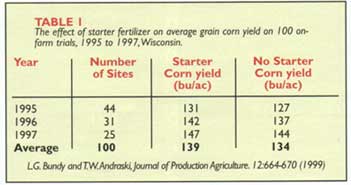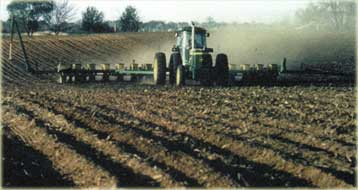

By Greg Stewart, OMAFRA Corn Specialist
| Recent results from a large starter fertilizer study in Wisconsin challenge some previously held beliefs about when starter fertilizer pays in corn. |
 Sometimes,
increased grain yields and/or lower harvest moistures are obtained as a result
of starter fertilizer applications, even when soil test levels are relatively
high. It is generally believed that this is the result of the enhanced availability
that comes from positioning the starter near the seed.
Sometimes,
increased grain yields and/or lower harvest moistures are obtained as a result
of starter fertilizer applications, even when soil test levels are relatively
high. It is generally believed that this is the result of the enhanced availability
that comes from positioning the starter near the seed.
The time and resources required to place dry starter fertilizers in a corn planting system does not, however, consistently result in a net economic benefit. Many corn producers must decide whether to reduce planter cost by eliminating dry fertilizer equipment, or to reduce complexity and speed of planting by not applying starter fertilizer.
In Ontario research, cool soil temperatures
have been shown to reduce soil phosphorous  availability
to plant roots. Cool temperatures also slow root growth, reducing nutrient
interception and uptake by the corn plant. Because of these factors, starter
use has been perceived as having potential merit, even on high testing soils,
when corn is planted early, in cool soils. However, several studies in the
U.S. Corn Belt have indicated that profitable starter response, on high testing
soils, has not been restricted to early planting dates. A study conducted
in Wisconsin during the years 1995-1997 examined starter placement on a large
number of fields that tested relatively high for P and K. The starter fertilizers
employed in this study were not identical at all of the test sites, but there
was always a starter (5 cm by 5 cm planter-applied band) versus a 'no starter'
comparison. The average rate of application for the starter plots across the
entire study was 15(N) - 26(P2O5) - 32(K2O) lbs per acre. The researchers,
L. Bundy and T. Andraski, University of Wisconsin, found that there was an
economically profitable corn response on these soils in 40 of the 100 field
sites tested. Table 1 outlines the number of sites tested each year and corn
yields recorded for starter and no starter treatments.
availability
to plant roots. Cool temperatures also slow root growth, reducing nutrient
interception and uptake by the corn plant. Because of these factors, starter
use has been perceived as having potential merit, even on high testing soils,
when corn is planted early, in cool soils. However, several studies in the
U.S. Corn Belt have indicated that profitable starter response, on high testing
soils, has not been restricted to early planting dates. A study conducted
in Wisconsin during the years 1995-1997 examined starter placement on a large
number of fields that tested relatively high for P and K. The starter fertilizers
employed in this study were not identical at all of the test sites, but there
was always a starter (5 cm by 5 cm planter-applied band) versus a 'no starter'
comparison. The average rate of application for the starter plots across the
entire study was 15(N) - 26(P2O5) - 32(K2O) lbs per acre. The researchers,
L. Bundy and T. Andraski, University of Wisconsin, found that there was an
economically profitable corn response on these soils in 40 of the 100 field
sites tested. Table 1 outlines the number of sites tested each year and corn
yields recorded for starter and no starter treatments.
The interesting part of the conclusions from
this study was that there was a significant tendency for starter fertilizers
to have a more positive impact when the following three conditions were met:
. delayed planting dates
. planting of longer season hybrids
. soil tests for K less than 140 ppm.
This is in contrast to the belief that starters in early planted/cool soils
may have a greater impact on these types of fields. More frequent responses
to starter fertilizer with late planting dates and hybrids may be due to the
starter's stimulation of vital early season growth rates. This results in
a realization of more of the crop's yield potential and avoidance of late
season frost injury.
In the future, if Ontario corn producers find themselves forced into delayed planting dates, and elect to plant full or near-full season hybrids, starter fertilizers may provide real yield benefits.